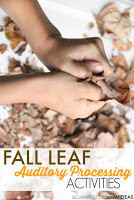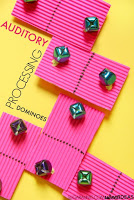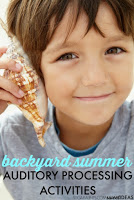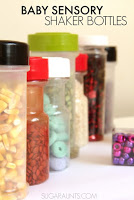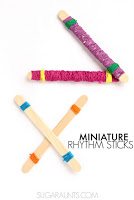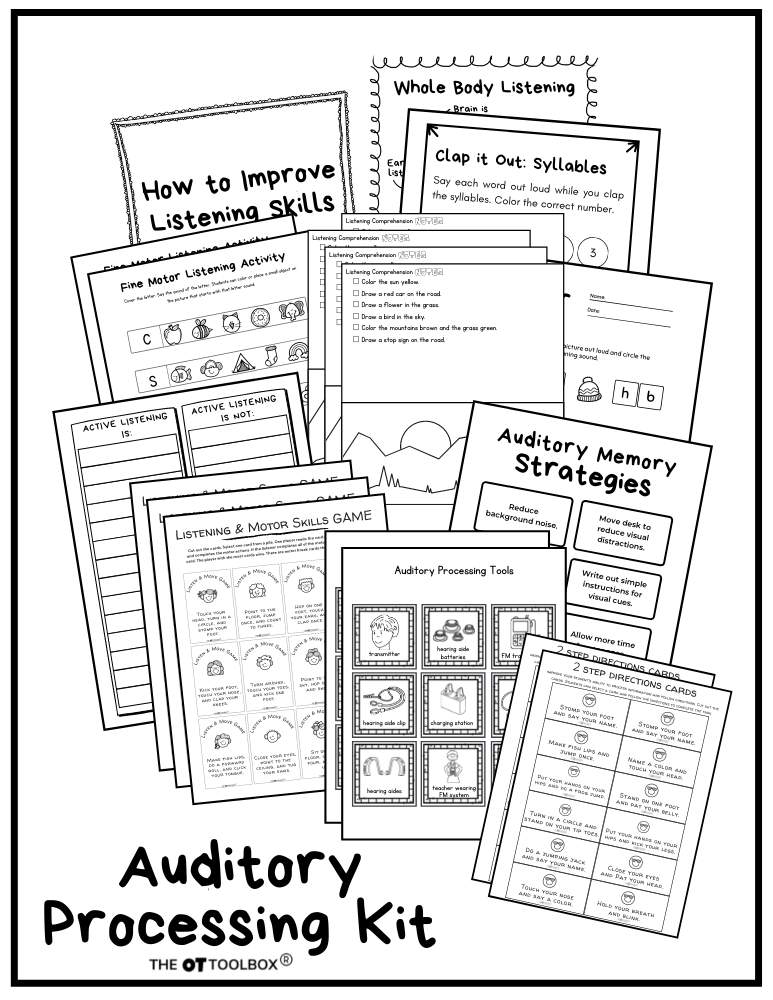Here, we are talking all about auditory processing activities that are part of sensory play for kids. Auditory processing activities are a tool for many auditory processing disorders or issues. From poor listening skills to difficulty with language comprehension, or auditory sensory sensitivities, activities that challenge the sense of hearing can be helpful for many children.
Try these auditory processing activities to help kids of many different skill levels.
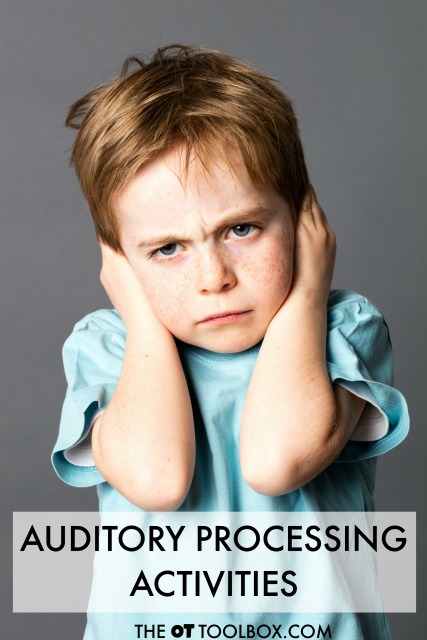
The Auditory Processing System
This information on the auditory processing system is taken from my book, The Sensory Lifestyle Handbook. For tips, tools, and strategies to integrate sensory processing information (in the right way) into daily life tasks like play, self-care, school, learning, and everyday functional tasks, check out The Sensory Lifestyle Handbook.
Receptors for the auditory system are located in the inner ear and are responsible for receiving vibration from sound waves and changing them to fluid movement energy. Information is projected to the central nervous system and transmits sound frequency as well as timing and intensity of sound input. The auditory system is integrated with somatosensory input in order to play a role in controlling orientation of the eyes, head, and body to sound.
Treatment activities may provide alerting input that help the child become more aware of their sensory needs through their mouth. They are activities that calm and add focus so that children can better attend to their environment and sensory input or needs is less of a primary focus.
Like all of the sensory systems, the auditory system can over-respond or under-respond to input from the world around us. When this occurs, we may notice that children respond in different or unusual ways than what we might expect.
Typically, dysfunction within the sensory systems presents in many different ways. A child with sensory difficulties may be over-responsive or under-responsive to sensory input.
They may operate on an unusually high or unusually low level of activity. They may fatigue easily during activity or may constantly be in motion. They might over-react to input from the environment.
Children may also fluctuate between responsiveness, activity levels, and energy levels. Additionally, children with sensory processing dysfunctions typically present with other delays. Development of motor coordination, fine motor skills, gross motor skills, social-emotional skills, behaviors, executive functioning skills, language, and learning are all at risk as a result of impaired sensory processing. This can be especially common for auditory processing issues.
Sensitivities to sounds may result in communication challenges, social and emotional learning, phonologic awareness delays, literacy delays, and trouble with reading or learning.
Hyper-responsiveness occurs when sensory input is “too loud” or “too much” for the individual. They over-react to auditory input.
Auditory sensitivities can look like different things for different individuals. Different settings and environmental situations can have a wide number of variances that impact one in a multitude of ways. For example, in the backyard, auditory considerations might be outside sounds that distract one from functional tasks like taking out the garbage, playing, walking the dog. This functional impact looks very different and has very different consequences than the safety of crossing a road, getting the mail on a street, or navigating a parking lot.
Auditory attention is another consideration. The impact of sensory input has on attending and focusing to specific instances may be limited due to auditory background noise, a specific tone of sound, a persistent or repeating sound, or a sound paired with vibration or light. Again, all of these considerations can be different for each individual. Read more on auditory attention here.
In an indoor situation, auditory attention and pulling out specific information from background noise can impact conversation, comprehension, learning, and again, safety, as well as overall functioning in essentially every functional task. This resource on auditory learning can impact auditory processing and learning.
Hyper-responsiveness of the auditory sense
Over-responsiveness in the auditory system may present in a child as over-responsiveness or overreaction to auditory sensation. This may look like sensitive ears or sensitivities to auditory input. Other examples of hypersensitivity may include:
- Startles easily to unexpected sounds
- Dislikes noisy places
- Overly sensitive to speakers on radios
- Fearful of smoke detectors, overhead speakers
- Shushes others or asks others to stop talking
- Holds hands over ears
- Sensitive to certain sounds such as lawnmowers or the hum of the refrigerator
- Easily distracted by sounds and background noise
- Hums to block out background noise
Adaptations/Accommodations to address hyper-responsiveness of the auditory sense:
- Calming auditory input: fill a plastic bottle with rice to use as a sensory sound tool
- Use foam earplugs
- Use earbuds or headphones to dull sounds, especially in noisy environments
- Soft/calm music
- Add soft material like felt or cut tennis balls to the bottoms of desk chairs and desks
- Allow student to travel hallways minutes before other students to reduce noise
Hypo-responsiveness of the auditory sense
Hypo-responsiveness is an under-responsiveness to auditory input. Children that are under-responsive may not notice sounds. They might create sounds of their own, like humming, or prefer loud sounds. They may not notice that they yell or speak loudly.
Other examples of under responsiveness to the auditory sense may look like:
- Seems to be unaware of sounds
- Holds radio speakers up against ears
- Doesn’t respond to alarms
- Makes silly sounds at inappropriate times or frequently
- Mimics sounds of others
- Talks to self
- Difficulty locating sounds, especially when in a noisy environment
- Hums in order to hear the sound of humming
Adaptations/Accommodations to address hypo-responsiveness of the auditory sense:
- Utilize visual schedules or visual prompts
- Utilize a physical prompt or “secret code” to indicate a transition
- Slow down speech when giving directions
- Seat child away from hallways, windows, or busy areas
- Trial a whisper phone in the classroom
- Teach child to tap out instructions or repeat instructions
Auditory Processing Activities
Studies support the use of active participation in multi-sensory activities for at least 90 minutes per week to improve occupational performance and autism symptoms and behaviors (Fazlioglu & Baran, 2008; Thompson, 2011; Woo & Leon, 2013; Wuang, Wang, Huang, & Su 2010).
Children who have a toolbox of sensory activities available to them for daily use may benefit from prescribed sensory activities. A sensory-based strategy guide can help.
You may have heard about using a sensory diet to address sensory challenges. But do you know where to start or even what a sensory diet is?
Students that struggle with learning as a result of overly responsive or under-responsive auditory sensory systems can be challenged as well. Check out our resource on auditory sensitivities in the classroom.
Activities that address several different areas are helpful for kids APD:
- Auditory discrimination
- Auditory sequencing
- Auditory memory
- Auditory figure-ground discrimination
Read more about the challenges of auditory processing disorders.
Each of the auditory activities listed below are ways to support auditory processing. They can be ways to offer auditory support through experience in pulling out specific sounds from background noise. The auditory activities listed below are also fun ways to challenge comprehension and support working memory with sounds. Below these auditory ideas, you’ll find specific auditory processing strategies.
- Fall Leaf Auditory Processing Activity
- Musical Bell Auditory Processing Activity
- Auditory Processing Activity Backyard Ideas
- Sensory Shaker Bottles Auditory Processing Activity
- DIY Rhythm Sticks
- Core strengthening with music and movement
- DIY Xylophone and sound discrimination
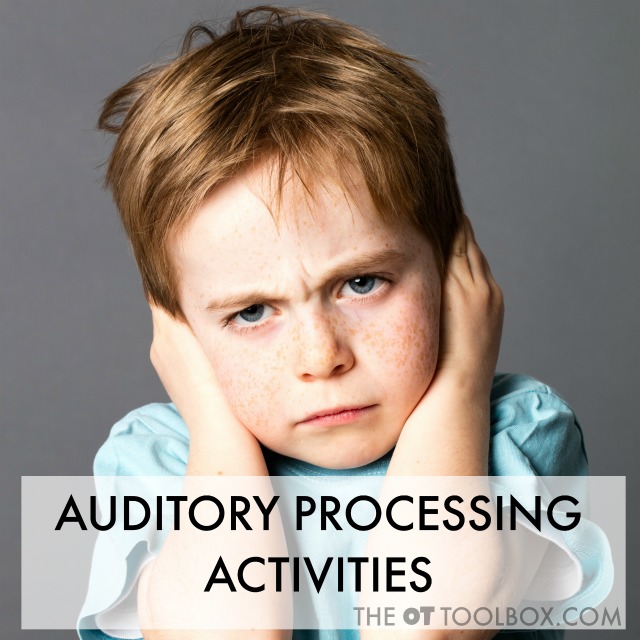
Auditory Processing Strategies
These tactics can be specific ways to support auditory processing differences in order to impact social emotional skills, learning, and functional participation.
Consider some of these auditory processing strategies:
- Reduce background noise
- Consider vibration and sound bounce, or the echo of sounds.
- Repeat instructions
- Ask the individual to repeat back instructions
- Provide written instructions
- Use a visual schedule
- Sound speed- speak at a slower rate, or record instructions and slow down the play back speed
- Consider location, especially in learning environments
- Add pauses when speaking
- Practice rhyming
- Practice saying lists of words that begin with the same sound or end with the same sound
- Use a whisper phone
- Practice the localization of sounds
- Draw to music
- Dance to music
- Pre-teach new vocabulary/concepts
- Play direction following games like Red Light, Green Light; Simon Says; Hokey Pokey; and Hot/Cold
- Practice, with the individual, the ability to identify environmental sounds and where they are coming from
- Allow extra time for the child to respond to questions.
Auditory Discrimination Games
Listed above, you’ll notice there are some direction-following games listed. These games are fun ways to work on auditory skills while focusing on different skills: auditory discrimination, auditory figure-ground, comprehension, and auditory memory are some skills addressed. Let’s go into more detail on these games, and here’s why:
These auditory discrimination activities are listening activities that can include movement, building other functional skills and motor development. Consider adding these ideas to therapy sessions as a brain break for regulation needs, or using them in an obstacle course as a movement and coordination task. Other ideas include using the listening games in play, social emotional skill development, and as a transition task.
- Red Light, Green Light- Listener needs to pay attention to listen for auditory directions “red light” to stop, “yellow light” to walk slowly, and “green light” to run fast. Use this movement game to address auditory attention, auditory memory, auditory discrimination, and auditory figure-ground.
- Simon Says- Listeners need to listen and discriminate auditory information to listen for parts of the directions to hear the words “Simon Says” before they complete an action. This is a good game for auditory attention, auditory memory, auditory discrimination, and auditory figure-ground.
- Freeze Dance- Listeners need to listen to music and dance while the music is on and then stop when the music stops. This is a great game for developing auditory attention and addressing auditory distraction.
- Hokey Pokey- Play the classic movement game of hokey pokey. Players can take turns adding movements and making up actions. This is a good game for auditory attention, auditory memory, auditory discrimination, and auditory figure-ground.
- Musical Charades- Play the classic charades game with cards that instruct kids to make different noises, speak in different tones or volume. Sound charade ideas can include: whisper, shout, hum, sing, growl, or sing various songs. This is a game that challenges auditory discrimination, auditory memory, and auditory attention.
- Hot/Cold Listening Game- One player hides an object while another player hides their eyes. Then the other player looks for the hidden object. When they are close to the hiding spot, the player says HOT. When they are far from the hidden object the player that hid the item says COLD. This game could also be played by singing or humming. When the finder is near the hidden item, they can sing or hum louder and when the finder is far from the hidden object the hider can sing or hum softly. This is a great game for auditory discrimination.
- I Went to a Picnic- A group takes turns saying items they will take on a picnic. The first player says, “I’m going on a picnic and I’m bringing…” as they say an item that begins with the letter A. The next player says “I’m going on a picnic and I’m bringing” as they repeat the item the first player said and then they ad an item that begins with the letter B. The game continues through the alphabet. Listeners need to use auditory memory to recall items that others in the group listed, and then verbalize those items.
All of these games integrate motor and sensory input and can be used to address tone, pitch, background sounds, and other auditory processing skills.
Auditory Discrimination Activities
What is Auditory Discrimination?
Auditory discrimination refers to the ability to recognize similarities and differences between sounds, words, and parts of speech. This is a skill needed to identify and discriminate between beginnging sounds, middle sounds, and ending sounds, especially needed for rhyming.
In addition to the auditory discrimination activities listed above, here are some additional activities that support this skill.
- Blend letters together to make a word
- Rhyme words
- Identify words that don’t rhyme
Auditory Processing Activities for Therapy
All of the ideas listed here can address skills covered in therapy. For more ways to address specific auditory processing skills, check out our new Auditory Processing Bundle.
The Auditory Processing Kit is a printable packet to address listening skills, whole body listening, listening comprehension, active listening, and auditory processing needs. This printable packet contains active listening activities, hands-on strategies, activity cards, visual cards, handouts, and more.
The Auditory Processing Kit is your therapy toolbox for addressing listening comprehension, auditory processing needs, and much more:
- Listening Comprehension
- Fine Motor Listening Skills
- How to Improve Listening Skills Poster
- Clap It Out Syllables Orthographic Activities
- Beginning Sounds Letter Activity
- Rhyming Words Activity
- Activity Listening Activity
- Hearing Skills Activity
- Auditory Memory Strategies
- What Does Active Listening Look Like?
- Whole Body Listening Activity
- Whole Body Listening Poster
- MORE
Click here to check out the Auditory Processing Kit.

Colleen Beck, OTR/L has been an occupational therapist since 2000, working in school-based, hand therapy, outpatient peds, EI, and SNF. Colleen created The OT Toolbox to inspire therapists, teachers, and parents with easy and fun tools to help children thrive. Read her story about going from an OT making $3/hour (after paying for kids’ childcare) to a full-time OT resource creator for millions of readers. Want to collaborate? Send an email to contact@theottoolbox.com.


